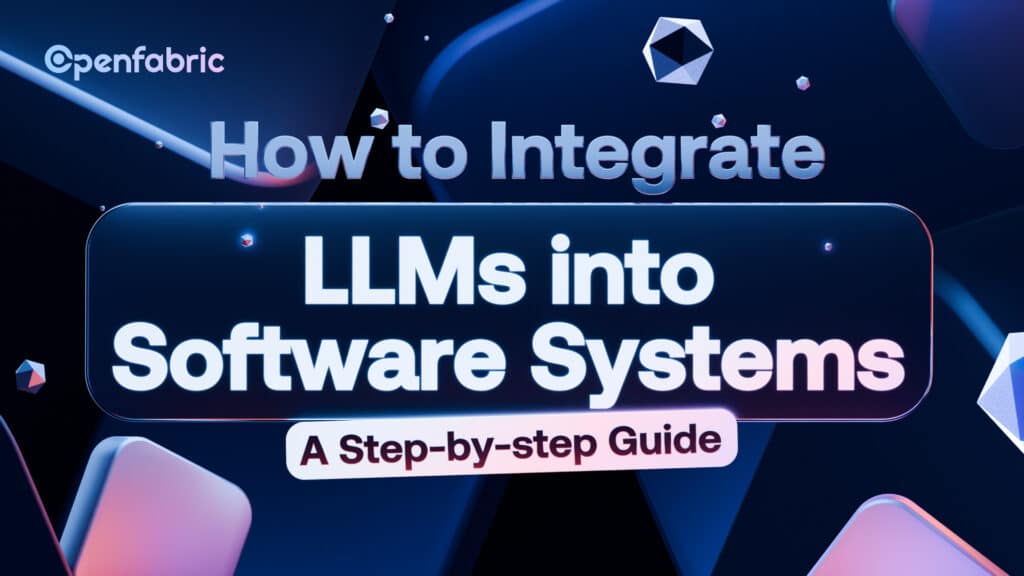
March 28, 2025 7 minutes read
How to Integrate LLMs into Software Systems: A Step-by-step Guide

As a startup company when you build an AI app, the app first does well with a few users. It is completely manageable at this point. Customers send emails and chat, there is a small team that responds within working hours, customers are happy, the team is happy and overall everything is going great. However, as your user base grows, the emails and requests via your chat channels increase too. They pile up, your customers are frustrated from waiting, your team is overwhelmed by the sheer volume of work and everything is falling apart. Why not try to integrate LLMs into software systems at your startup?
Large Language Models are AI models built to scale and make AI tools and software systems more efficient. These models are trained on vast amounts of data, giving them a wide knowledge base. The catch with LLMs is that they generate coherent, context-related responses to queries in a human-like manner.
Essentially, LLMs are important. But where do you start from? How do you integrate LLMs into software systems to make them scale? These are the questions that this guide aims to answer alongside some challenges that may be encountered on the way. However, they say the journey of a thousand miles begins with a step.
Let’s get started!
General overview and benefits of LLMs
As exciting as it would be to just get right into learning how to integrate LLMs into software systems, we need to have a simple understanding of what LLMs are.
Earlier in this article, we pointed out that LLMs are AI models built to scale and improve efficiency. The amount of data they are trained on makes them an island of information. Above all, they respond to users according to the context of the discussion, in a language the users understand.
On the other side of LLMs, we have Small Language Models (SLMs). They are AI models capable of processing and generating natural language content just like LLMs. The difference, however, is that SLMs are not built to scale as much as LLMs because they are trained on fewer parameters than LLMs. Read a better comparison of LLMs and SLMs HERE.
LLMs are not only designed to scale. There are numerous benefits that make it necessary to integrate LLMs into software systems.
Why you should integrate LLMs into software systems
Improved data analysis
LLMs process and interpret large amounts of data. Due to their exposure to hundreds of billions of parameters, they process and interpret data with better accuracy and speed than traditional methods. As a result, they provide you with valuable insights to make better decisions.
Smarter conversations with customers
Have you ever had an experience where a chatbot kept giving inaccurate responses because it didn’t understand basic questions? LLMs fix that. In business, it’s all about your customers. When things don’t work the way they should, customers get frustrated and leave. LLMs make chatbots interact with customers in a human-like manner. They understand the context of the conversation and even the sentiment. Therefore, they respond to customers accurately with context-related responses to their queries.
Better user experience and customer service
When a software system is integrated with LLM, it is able to handle a bunch of tasks with accuracy. For instance, a crypto trading bot integrated with LLM does not only trade crypto. In addition to trading, it provides traders with insights, has calculation functions, and even suggests promising trades. This multifunctional ability gives users a better experience while using such software.
Also, customer service is better as queries are responded to faster, even outside working hours. Therefore, customers can always get answers to fix any type of problem encountered, at any time.
Customizability and Scalability
When you integrate LLMs into software system, you can tweak it to perfectly fit into your industry’s specific needs and use cases. Using LLMs is kind of like an open check because you choose how much value you want to get from it. As such, it perfectly accommodates your startup as it grows.
LLMs solve a lot of issues in an AI app or tool. However, to get all these benefits, you must first learn how to integrate LLMs into software systems.
The guide to integrate LLMs into software systems
The outcome and performance of an AI tool depend on how the LLM that governs it performs. Therefore, integrating LLMs into software systems requires careful planning and execution. However, with the help of this guide, you too will be able to integrate LLMs into software systems to get them to work the way you want them to. Let us see a step-by-step approach to integrate LLMs into software systems.
Start with the goal
First ask yourself: what problem are you trying to solve? What determines the LLM to use or the tuning of that LLM all depends on the goal or the problem you are trying to solve. Where there is no issue with customer support, for example, choosing an LLM to answer emails and queries faster will only lead to waste while leaving the main problem unsolved. With your goal in mind, you have a direction to which you are heading, and the path becomes clearer.
Select the right model
Just like our fingers aren’t equal, so are LLMs. Not all LLMs are created equally or for the same purpose. While all LLMs are created for larger tasks than SLMs, there are some LLMs that handle much larger and more complex tasks than other LLMs. In the same vein, some LLMs are more flexible and scale better than others. Ultimately, the choice of an LLM for integration is determined by an interplay of several factors such as cost, flexibility and accuracy of the model, and main purpose. No LLM contains everything in satisfactory amounts.
Feed accurate data to the LLM
LLMs are as good and accurate as the data you feed them. Put together all the relevant data, ensure they are accurate, and eliminate all forms of bias from the data to achieve a perfect outcome. Bad data gives undesirable results.
Select the desirable mechanism for integration
To integrate LLMs into software systems, there are mechanisms through which you can host. There are various mechanisms through which you can host an LLM. LLMs can be integrated through APIs or self-hosting the model.
In using APIs, you are only concerned with the cost of acquiring access through API keys. Once this is done, you don’t have to worry about the software updates of the API, because the API provider takes care of it. Another thing worthy of note is that APIs are public, therefore giving it access to private information might not be a good idea.
However, when you self-host the model, it allows you to fine-tune the model and tweak it the way your business needs it. You control the cost, performance, and it is more private in comparison to API service.
As a rule of thumb, the mechanism to integrate LLM into system software of an industry, depends on how much priority data privacy carries. For instance, industries concerned with health care will use a mechanism that is more private due to the sensitive nature of their customers’ data.
Assemble, Test, and Repeat
Integrating LLMs isn’t a one-time thing. After you have put everything together, you use backend frameworks to serve your LLM models. Use them to interact with your LLM and receive feedback. These feedbacks allow you to assess the success of the model and make adjustments where necessary before the AI tools go live.
Check regularly for maintenance of function
Congratulations on deploying your AI tool fully integrated with LLM designed to scale. However, you cannot totally relax just yet. Unfortunately, models drift over time as their output quality might decrease as they come across new types of data and learn from them. The end result might not be exactly what you were initially going for. Therefore, ensure to update the model regularly to keep things running smoothly.
Conclusion
The growth of every startup depends on how well they can keep their customers. Initially, this might not be so difficult as the customer base is small, but as the company grows there is a need to integrate LLMs into the software system of the company in order to effectively manage the workflows. For a startup, integrating LLMs into AI tools feels like stepping into uncharted territory. However, by following this guide you can build AI tools that are flexible and designed to scale as needed.
Ultimately, it is not about building the most complex AI tools, but about building tools that solve real-world problems.
For more updates and step-by-step guides, visit our WEBSITE today!

